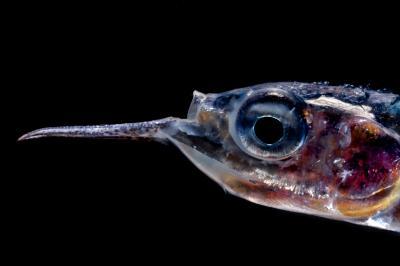Mesopelagic fishes like lantern fishes (Myctophidae) and cyclothonids (Gonostomatidae) live in the twilight zone of the ocean, between 200 and 1,000 meters deep.
With a stock estimated at 1,000 million tons so far, mesopelagic fish dominate the total biomass of fish in the ocean and are the most numerous vertebrates of the biosphere. Now it turns out they have been severely underestimated. Researchers writing in Nature Communications have estimated their numbers are 10 times higher than previous estimated, based on acoustic observations conducted during the circumnavigation of the Malaspina Expedition.
During the 32,000 nautical miles traveled during the circumnavigation, the researchers of the Malaspina Expedition, led by Spanish National Research Council (CSIC) researcher Carlos Duarte, took measurements between 40°N and 40°S, from 200 to 1,000 meters deep and they obtained a more accurate estimate than before.
"Until now we only had the data provided by trawling," says Duarte. "It has recently been discovered that these fishes are able to detect the nets and run, which turns trawling into a biased tool when it comes to count its biomass."

Mesopelagic fish come up at night to the upper layers of the ocean to feed, whereas they go back down during the day in order to avoid being detected by their predators. This behavior speeds up the transport of organic matter into the ocean, the engine of the biological pump that removes CO2 from the atmosphere, because instead of slowly sinking from the surface, it is rapidly transported to 500 and 700 meters deep and released in the form of feces.
Xabier Irigoyen, researcher from AZTI-Tecnalia and KAUST (Saudi Arabia) and head of this research, states, "The fact that the biomass of mesopelagic fish (and therefore also the total biomass of fishes) is at least 10 times higher than previously thought, has significant implications in the understanding of carbon fluxes in the ocean and the operation of which, so far, we considered ocean deserts.
"Mesopelagic fish accelerate the flux for actively transporting organic matter from the upper layers of the water column, where most of the organic carbon coming from the flow of sedimentary particles is lost. Their role in the biogeochemical cycles of ocean ecosystems and global ocean has to be reconsidered, as it is likely that they are breathing between 1% and 10% of the primary production in deep waters."
According to researchers, the excretion of material from the surface could partly explain the unexpected microbial respiration registered in these deep layers of the ocean. Mesopelagic fishes would act therefore as a link between plankton and top predators, and they would have a key role in reducing the oxygen from the depths of the open ocean.





Comments